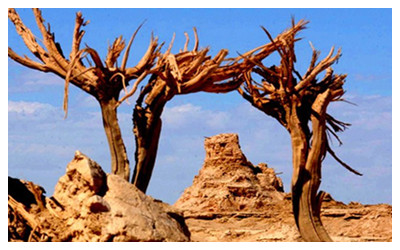Skype: neodalle-travel
Tel: +86 135 7447 2266
E-mail: sales@visitaroundchina.com
Loulan Ancient City, one of the great mysteries in Chinese history, is the disappearance of the ancient city. The ancient city was located about 300 km northeast of Ruoqiang County, Xinjiang Uygur Autonomous Region and adjacent to another early city, Dunhuang in Gansu Province.
 Loulan Ancient City was established as a kingdom in 176 B.C. and flourished for over 800 years. The city was like an oasis traversed by a limpid river and situated next to a bountiful lake. The city had a population of over 14,000 including an estimated 3,000 soldiers guarding the safety of the kingdom. Many residents made a living fishing and hunting. As one of the major stops on the old Silk Road, the city was a center for the trading of silks, teas, fruit and jewels with the inland. Merchants also used Loulan as a stopover in their travels. In short, the kingdom was booming economically while serving as a peaceful and paradisiacal environment for its citizens and visitors.
Loulan Ancient City was established as a kingdom in 176 B.C. and flourished for over 800 years. The city was like an oasis traversed by a limpid river and situated next to a bountiful lake. The city had a population of over 14,000 including an estimated 3,000 soldiers guarding the safety of the kingdom. Many residents made a living fishing and hunting. As one of the major stops on the old Silk Road, the city was a center for the trading of silks, teas, fruit and jewels with the inland. Merchants also used Loulan as a stopover in their travels. In short, the kingdom was booming economically while serving as a peaceful and paradisiacal environment for its citizens and visitors.
Roughly around the year 630, Loulan suffered a natural disaster of epic proportions. Due to humans' unceasing deforestation, raging sandstorms covered the region, rerouting the waterways and literally transformed the city into a desert wasteland. To this day, the terrain is barely navigable and there are severe weather fluctuations. In the summer, the temperature has been known to shift from below 0 degrees C. to over 30 degrees C. from the night to the daytime. The region is extremely arid and continues to be subjected to frequent wind and sand storms. Conditions are so harsh that the area has become known as the 'Death Sea.'
Only in recent years have archaeologists ventured into Loulan. Because of the dangerous environment, some actually have lost their lives. However, those that were able to conduct a successful dig found priceless treasures. The store of cultural relics included stone and jade tools and stone arrowheads dating back to the Neolithic Age (10,000 BC-5,000 BC). They also found manuscripts from the Han Dynasty (206 BC-220 AD) as well as silk, pottery, bronzeware, glassware, and ancient currency. So rich were these troves that researchers from around the world have dubbed this area 'Treasure Land of the Desert' and 'Museum Left by History.'
Perhaps the most famous discovery at the ancient city site is the Sanjian Fang, a three-room building said to be the yamen of the area's governor, and a pagoda with 10.4 m.high, the tallest building in the city. They also found a woman mummy, the called 'Loulan Beauty', in the Loulan ancient tomb ditch. The sere corpse is still reserved well after over three thousand years.
Like Pompeii in ancient Rome which drowned in a sea of volcanic ash, Loulan Ancient City fell victim to an incredible natural disaster that transformed the once beautiful city into a barren and perilous desert landscape. This inexplicable event has whetted the curiosity of archaeologists and other scientists over the years. Tourists, too, have been intrigued by this site and many venture there despite adverse weather and terrain conditions.
Travel Tips
Add: 300 km northeast of Ruoqiang County, Xinjiang Uygur Autonomous Region
Admission Fee: CNY 5
Opening Hours: 08:00 – 16:00
Best time to visit: Spring and Autumn
Remarks: Because of the difficult elements, Loulan is also known as 'the forbidden zone.' Bring lots of water, warm clothes, necessary medicines, handi-wipes and eyedrops. Be prepared for high temperatures and dust. The road to the ancient city is extremely difficult and it is advised that visitors travel in groups. Visitors should also be reasonably fit. There are sightseeing buses in Ruoqiang County, but they cannot enter the archaeological site. If you want to go to the location of the cultural relics, you will need to either walk or ride a camel.
 Ask Questions ?
Ask Questions ?